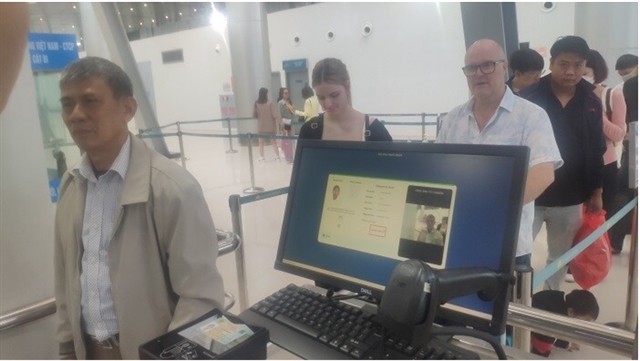 Society
Society

 |
| A passenger is verified by biometric authentication in Cát Bi International Airport of Hải Phòng. — Photo baogiaothong.vn |
HÀ NỘI — The Airports Corporation of Việt Nam (ACV) is testing a biometric authentication system for passengers who use electronic identity cards in the aviation security check process.
Accordingly, Cát Bi International Airport in Hải Phòng was the first airport to install the testing equipment and software from February 1, 2023.
Cát Bi International Airport will pilot the use of a separate lane for domestic passengers using electronic ID cards.
Up to now, the number of test passengers was 758, said ACV’s leader.
The number of recognised ID cards was 746, reaching 98.4 per cent, and the rate of face recognition by cameras was 100 per cent.
Average time to read an ID card and boarding pass is approximately 15 seconds per passenger while the average time to process one passenger is 60 seconds, he said.
The test results showed that the system has effectively supported aviation security forces in passenger control.
However, there are still some problems such as the slow speed of reading electronic ID cards by the devices, especially for cards that are faulty, dirty or with blurred codes.
With the use of the passenger authentication system for electronic ID card holders, ACV will install electronic ID card reader devices and cameras at security check points to match the passenger's face with the information available in the ID cards.
VeriPAX software developed by ACV will display all information read from ID cards and itinerary information connected with the list of passengers who have checked in to compare boarding passes with passenger flights.
VeriPAX also connects to a database of a list of those banned from flying of the Civil Aviation Authority of Việt Nam (CAAV) so as to quickly identify whether the passenger is banned from flight or not.
In addition, the software has a warning feature in case passengers need to have their baggage visually checked as well as processing passengers using other types of identification papers.
At passenger security checkpoints, the aviation security officer will scan passengers’ ID cards and boarding passes with specialised devices to match with passengers’ faces.
The system authenticates ID cards and returns results of passenger information verification, itinerary information, matches with the no-fly list or mandatory visual check and visual check-in baggage.
If the system records the information on the ID cards and the face image matches the journey information, aviation officers will let the passengers move into the screening area.
Previously, CAAV co-ordinated with ACV to guide Vân Đồn International Airport in Quảng Ninh Province and other relevant offices to deploy biometric authentication upon arrival for Vietnamese citizens at airports.
Vân Đồn International Airport will complete the pilot implementation of passenger biometric authentication by machine by the first quarter of this year and report to CAAV.
After the pilot programme, the airport will officially implement the biometric authentication for passengers before June 30.
At the same time, CAAV requested ACV to continue implementing the pilot programme in other airports.
ACV is also required to study technology options to handle situations such as passengers doing self-check-in at kiosks or by phone as well as requesting technology solution providers to complete legal procedures and provide solutions to ensure the safety of passengers’ information.
The establishment of a connection system between the airports and the ID database of the Ministry of Public Security aims to control passengers on domestic flights as well as prevent and promptly detect cases where passengers use fake documents or persons who are banned from flying. — VNS




